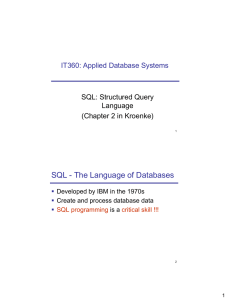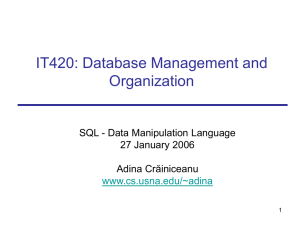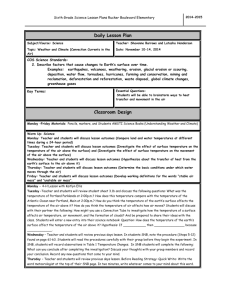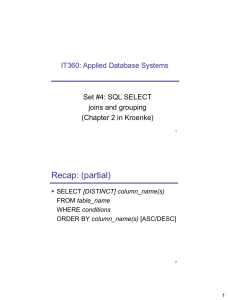Class Exercise IT420: Database Management and Organization
advertisement
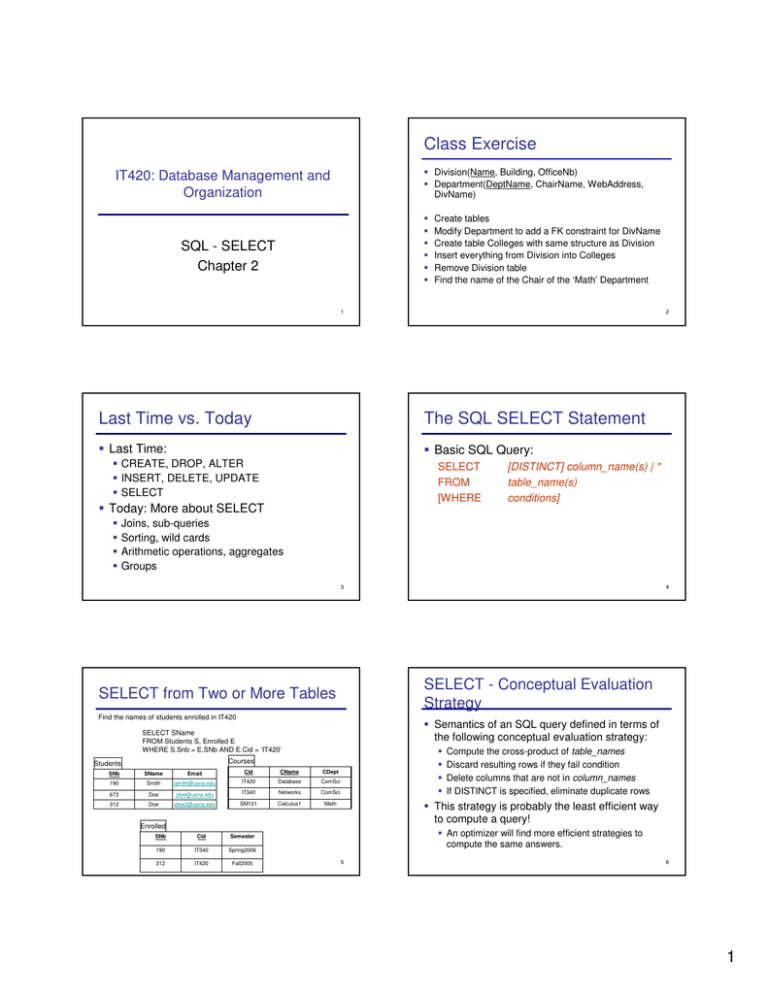
Class Exercise Division(Name, Building, OfficeNb) Department(DeptName, ChairName, WebAddress, DivName) IT420: Database Management and Organization SQL - SELECT Chapter 2 Create tables Modify Department to add a FK constraint for DivName Create table Colleges with same structure as Division Insert everything from Division into Colleges Remove Division table Find the name of the Chair of the ‘Math’ Department 1 2 Last Time vs. Today The SQL SELECT Statement Last Time: Basic SQL Query: CREATE, DROP, ALTER INSERT, DELETE, UPDATE SELECT SELECT FROM [WHERE Today: More about SELECT [DISTINCT] column_name(s) | * table_name(s) conditions] Joins, sub-queries Sorting, wild cards Arithmetic operations, aggregates Groups 3 SELECT - Conceptual Evaluation Strategy SELECT from Two or More Tables Find the names of students enrolled in IT420 Semantics of an SQL query defined in terms of the following conceptual evaluation strategy: SELECT SName FROM Students S, Enrolled E WHERE S.Snb = E.SNb AND E.Cid = ‘IT420’ Courses Students SNb SName Email Cid CName CDept 190 Smith jsmith@usna.edu IT420 Database ComSci 673 Doe jdoe@usna.edu IT340 Networks ComSci 312 Doe jdoe2@usna.edu SM121 Calculus1 Math Cid Semester 190 IT340 Spring2006 312 IT420 Fall2005 Compute the cross-product of table_names Discard resulting rows if they fail condition Delete columns that are not in column_names If DISTINCT is specified, eliminate duplicate rows This strategy is probably the least efficient way to compute a query! Enrolled SNb 4 An optimizer will find more efficient strategies to compute the same answers. 5 6 1 Example Conceptual Evaluation Example Conceptual Evaluation SELECT SName FROM Students S, Enrolled E WHERE S.Snb = E.SNb AND E.Cid = ‘IT420’ SELECT SName FROM Students S, Enrolled E WHERE S.Snb = E.SNb AND E.Cid = ‘IT420’ S.SNb SName Email E.SNb Cid Semester S.SNb SName Email E.SNb Cid Semester 190 Smith jsmith@usna.edu 190 IT340 Spring2006 190 Smith jsmith@usna.edu 190 IT340 Spring2006 190 Smith jsmith@usna.edu 312 IT420 Fall2005 190 Smith jsmith@usna.edu 312 IT420 Fall2005 673 Doe jdoe@usna.edu 190 IT340 Spring2006 673 Doe jdoe@usna.edu 190 IT340 Spring2006 673 Doe jdoe@usna.edu 312 IT420 Fall2005 673 Doe jdoe@usna.edu 312 IT420 Fall2005 312 Doe jdoe2@usna.edu 190 IT340 Spring2006 312 Doe jdoe2@usna.edu 190 IT340 Spring2006 312 Doe jdoe2@usna.edu 312 IT420 Fall2005 312 Doe jdoe2@usna.edu 312 IT420 Fall2005 7 Example Conceptual Evaluation SELECT SName FROM Students S, Enrolled E WHERE S.Snb = E.SNb AND E.Cid = ‘IT420’ Modified Query SELECT SNb FROM Students S, Enrolled E WHERE S.Snb = E.SNb AND E.Cid =‘IT420’ SName Doe S.SNb SName Email E.SNb Cid Semester 190 Smith jsmith@usna.edu 190 IT340 Spring2006 190 Smith jsmith@usna.edu 312 IT420 Fall2005 673 Doe jdoe@usna.edu 190 IT340 Spring2006 673 Doe jdoe@usna.edu 312 IT420 Fall2005 312 Doe jdoe2@usna.edu 190 IT340 Spring2006 312 Doe jdoe2@usna.edu 312 IT420 Fall2005 8 Would the result be different with DISTINCT? 9 Class Exercise 10 Sorting the Results Students(SNb, SName, Email) Courses(Cid,CName, Dept) Enrolled(SNb,Cid, Semester) SELECT [DISTINCT] column_name(s) | * FROM table_name(s) [WHERE conditions] [ORDER BY column_name(s) [ASC/DESC]] Example: Students(SNb, SName, Email, Major) Find the student number and name for each student enrolled in ‘Spring2007’ semester Find the names of all students enrolled in ‘ComSci’ courses SELECT SNb, SName FROM Students ORDER BY SName ASC, SNb DESC 11 12 2 WHERE Clause Options AND, OR IN, NOT IN, BETWEEN LIKE Calculations in SQL SELECT SNb, SName FROM Students WHERE SNb LIKE ’8%’ AND Major IN (‘SIT’, ‘SCS’) Wild cards: SQL-92 Standard (SQL Server, Oracle, etc.): _ = Exactly one character % = Any set of one or more characters MS Access ? * Simple arithmetic Five SQL Built-in Functions: = Exactly one character = Any set of one or more characters Example: Students(SNb, SName, Email, Major) Find alpha and name of SCS or SIT students with SNb starting with ‘8’ COUNT SUM AVG MIN MAX 13 Simple Arithmetic SELECT NbHours* HourlyRate AS Charge FROM FlightEvents Aggregate Operators SELECT COUNT(*) FROM Students Charge 150 400 SELECT COUNT(DISTINCT SName) FROM Students WHERE SNb > 700 50 400 SELECT SFirstName + ‘ ’ + SLastName FROM Students 14 (No column name) John Doe SELECT AVG(Age) FROM Students WHERE SNb LIKE ’08____’ Brad Johnson Jessica Smith Mary Davis 15 16 Aggregate Operators Limitations Select oldest students and their age Return only one row Not in WHERE clause SELECT S.SName, MAX (Age) FROM Students S Illegal! SELECT S.SName, S.Age Correct! FROM Students S WHERE S.AGE = (SELECT MAX(Age) FROM Students) Sub-query 17 18 3 Select students with age higher than average Class Exercise SELECT * FROM Students WHERE Age > AVG(Age) Students(SNb, SName, Email) Courses(Cid,CName, Dept) Enrolled(SNb,Cid, Semester) SELECT * FROM Students WHERE Age > (SELECT AVG(Age) FROM Students) Illegal! List SNb of all students enrolled in ‘IT420’ or ‘IT340’, ordered by SNb Correct! 19 20 Grouping rows GROUP-BY Clause Find the age of the youngest student for each class year SELECT MIN (S.Age) FROM Students S WHERE S.ClassYear = 2007 SELECT [DISTINCT] column_name(s) | aggregate_expr FROM table_name(s) [WHERE conditions] GROUP BY grouping_columns ClassYear Example: (no column name) 21 SELECT ClassYear, MIN(Age) FROM Students GROUP BY ClassYear 21 2007 2010 2009 2008 (no column name) 21 17 18 22 20 Conceptual Evaluation HAVING Clause Semantics of an SQL query defined as follows: SELECT [DISTINCT] column_name(s) | aggregate_expr FROM table_name(s) [WHERE conditions] GROUP BY grouping_columns HAVING group_conditions Compute the cross-product of tables in FROM (table_names) Discard resulting rows if they fail WHERE conditions Delete columns that are not in SELECT or GROUP BY(column_names or grouping-columns) Remaining rows are partitioned into groups by the value of the columns in grouping-columns One answer row is generated per group GROUP BY groups the rows HAVING restricts the groups presented in the result Note: Does not imply query will actually be evaluated this way! 23 24 4 Example- HAVING Conceptual Evaluation SELECT ClassYear, MIN(Age) FROM Students WHERE MajDeptName = ‘ComSci’ GROUP BY ClassYear HAVING COUNT(*) > 20 SQL query semantics: Compute the cross-product of table_names Discard resulting rows if they fail conditions Delete columns that are not specified in SELECT, GROUP BY Remaining rows are partitioned into groups by the value of the columns in grouping-columns One answer row is generated per group Discard resulting groups that do not satisfy group_conditions 25 26 Example Class Exercise SELECT Class, MIN(Age) FROM Students WHERE MajDeptName = ‘ComSci’ GROUP BY Class HAVING COUNT(*) > 2 Students(SNb, SName, Email) Courses(Cid,CName, Dept) Enrolled(SNb,Cid, Semester) List all course names, and the number of students enrolled in the course 27 28 Subqueries Subqueries in FROM Clause SELECT * FROM Students WHERE Age > (SELECT AVG(Age) FROM Students) Find name of students enrolled in both ‘IT420’ and ‘IT334’ SELECT FName + ‘ ’ + LName AS StudentName FROM Students, (SELECT Alpha FROM Enroll WHERE CourseID = ‘IT420’ AND Alpha IN (SELECT Alpha FROM Enroll WHERE CourseID = ‘IT334’) Second select is a subquery (or nested query) You can have subqueries in FROM or HAVING clause also ) AS ResultAlphaTable WHERE Students.Alpha = ResultAlphaTable.Alpha 30 31 5 Subqueries Exercise Class Exercise Students(Alpha, LName, FName, Class, Age) Enroll(Alpha, CourseID, Semester, Grade) 1. Find alpha for students enrolled in both ‘IT420’ and ‘IT334’ 2. Find name of students enrolled in both ‘IT420’ and ‘IT334’ Students(Alpha, LName, FName, Class, Age) Enroll(Alpha, CourseID, Semester, Grade) Find the name of students enrolled in ‘IT420’ Usual way Use subqueries 32 33 Class Exercise Summary What does this query compute: SELECT FName, LName FROM Students S, Enroll E1, Enroll E2 WHERE S.Alpha = E1.Alpha AND S.Alpha = E2.Alpha AND E1.CourseID = ‘IT420’ AND E2.CourseID = ‘IT344’ SELECT [DISTINCT] column_name(s) | aggregate_expr FROM table_name(s) WHERE conditions GROUP BY grouping_columns HAVING group_conditions ORDER BY column_name(s) [ASC/DESC] 34 35 6
